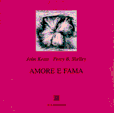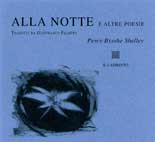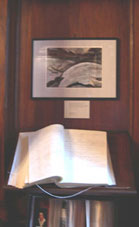
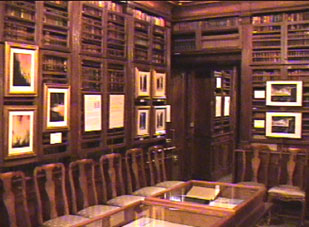
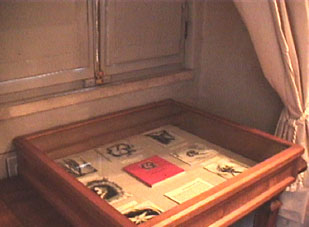
Related books
Italian language translation with original English text.
John Keats Percy B. Shelley
Book cover and drawings by Nancy Watkins
Percy Bysshe Shelley
Book cover and drawings by Nancy Watkins
Nancy Watkins
The publisher:
Il Labirinto
www.labirintolibri.com
The Poet's Room Nancy Watkins Keats-Shelley Museum Piazza di Spagna 26, Rome Italy |
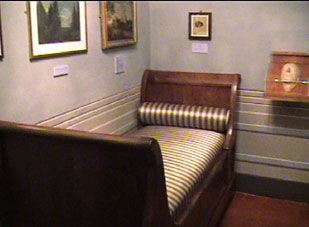 |
The Poet’s Room is the place of places, the secret space where
poetry and painting encounter each other. John Keats’s verse “This
room is as full of jewels as a mine” (The Cap and Bells) is Nancy
Watkins’s choice as epigraph of her show. The motif recurs in
the artist’s work; the paintings, executed over several years,
are variations and evolutions of the theme, and generate new references
and allusions in these rooms where the great English Romantic poet lived
briefly and died.
Using pictorial matter dense with cloudy darkness and radiance, the
artist introduces us into this “mind room”. She represents
its solid architectures and its more fluid, fleeting forms. The themes
of the show: doors, windows, mirrors - the mysterious Hyerusch Mirror
and the elusive Window-Mirror, to name two works - water, fire
and guardian demons, punctuate the journey through the Room and mind
of the poet.
The catalogue includes texts by Giuseppe Appella, Gianfranco Palmery,
Nancy Watkins.
Nancy Watkins has shown in galleries and museums in
Europe and North America. She is the author of two books of drawings
- Autoritratti senza lo specchio and Visite notturne.
Her works have been featured in many other publications including magazines
and special editions. Born in Chicago, she lives in Rome.
From the exhibition catalog:
|
The last, whom I
love more, the more of blame John Keats, ‘Ode on Indolence’
Guardian Demons III, Conté, 25 x 18 cm © 1993 by Nancy Watkins |
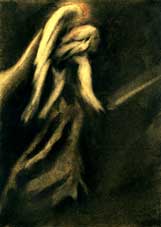 |
The Poet’s Room is a Two-fold Room
Gianfranco Palmery
Poets, as we know, spend the best of themselves in a fantastic or fantasy room, a ‘gorgeous room’, as opposed to the real room where their days are consumed; an ideal room, to which they dedicate bizarre exercises of interior decorating, even to the point of theorising a philosophy, as Poe did. At times their chimerical tastes in decors oddly coincide—as in the room Keats entrusts to his imaginative ‘Castle Builder’:
About my room,—I’ll have
it in the pink;
It should be rich and sombre, and the moon,
Just in its mid-life in the midst of June,
Should look thro’ four large windows and display
Clear...
and in that of Baudelaire, splenetic architect of the chambre double:
A room reminiscent of a reverie, a truly spiritual room, in which the stagnant atmosphere is lightly coloured rose and blue...
As for the draperies, ‘as tho’ they had
/ been made for Cleopatra’s winding-sheet’, in one, and
muslin that falls and billows in snowy cascades around the windows,
in the other... and here and there, roses and skulls. Whether it is
influence or a sign of their times, Keats and Baudelaire seem to share
the same room; a two-fold room—‘full of jewels as a mine’,
and together, as in Baudelaire, taudis (a hovel), séjour
de l’éternel ennui (the dwelling of eternal tedium);
the chambre haute in the chambre basse, the abode
down here.
The true room of the poet is his mind, and there, in his ‘world
of thought and mental might’ the artist has moved for years with
a special syntony. That room, the place where the poet receives visits
and visions, is familiar to Nancy Watkins, and her paintings and drawings,
having directly measured themselves against various poets’ verse,
gain a richness and intensity, rare in today’s world. Her art
does not harbour or indulge in contemporary clichés and it is
probably a partisan opinion, but I believe that this in some way derives
from her deep-rooted contact with poetry.
It certainly is not the literary references, the quotations—which
the artist does nevertheless use quite naturally in her work, and at
times not without irony—as much as the intensity of her painting
(I may say, almost heretically, its lyricism) that suggests from
the inside an unusual affinity with the processes of poetry. The
effect is of a dual postulation: that which the eye instantly perceives,
truly fascinated by colour, the mind then finds confirmed in the theme,
the title, the allusion.
It is best to add, however, that what I have just defined as ‘an
unusual affinity with the processes of poetry’ is perhaps none
other than the sign of the singularity and authenticity of an art that,
while nourished by literary suggestions, isn’t ‘literary’
at all. It is distinguished, rather, by a strong affirmation of pictorial
values.
Nancy Watkins manages to give classic form to modern pictorial gesture,
in that order of precedence and not the contrary. The artist is, in
fact, even if dialectically and at times antagonistically, a conscious
heir of the pictorial gesture, but she also never renounces the ancient
body of tradition. It may be dissipated or dispersed, but it is not
irrevocable, not lost—and her choice is still the most honest
and courageous way to live one’s own time: simultaneously to participate
and yet remain detached.
All this is shown in her interiors, fortified, burning hot, wide open
or windy, that open out onto scenes of water or of fire, theatrical,
but like backdrops of dreams: they are not views of the daytime world,
but rather visions, scenes of the mind,—once again, interiors.
Well then, let’s enter into the poet’s room. What do we
find? Books, papers, dust, relics, bric-a-brac? Certainly we can find
all these: the artist doesn’t exclude them, but likewise doesn’t
show them to us. What we have instead is a room which a restless psychic
energy turns topsy-turvy, filling with light, hallucinations, phantoms,
with fantasy-figments; but solid, so solidly constructed, that the turbulence
is contained and together the peak of quietness, of Apollonian attainment,
is achieved. Keats’s verses accompanying the paintings articulate,
like epigraphs, the time and forms: doors, windows, draperies, mirrors,
guardian demons, and imaginary scintillating vistas of stone and water,
with a final, tragic and ironic (like the February 1821 bonfire of the
poet’s poor furnishings in the piazza), purificatory
fire.
| Nancy Watkins
|
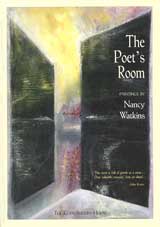 |
